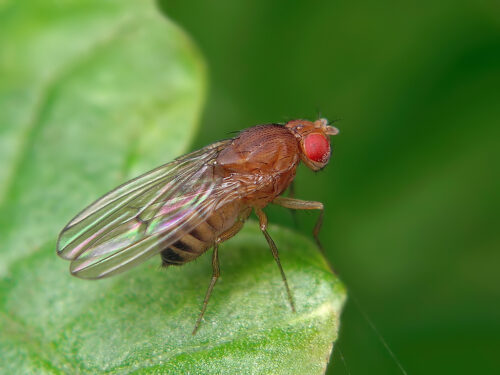How flies tune in to courtship songs. From Scope, the blog of the Yale Scientific Magazine.
Fruit fly mating is reminiscent of a medieval romance. Male fruit flies vibrate their wings to produce a unique courtship song that attracts females, who promptly choose whether they want to mate with the male.
The antennae of fruit flies are always vibrating, even when there is no sound present. “These vibrations are at the courtship song frequency, which makes the antenna ten times more sensitive to sounds in that frequency,” said Daniel Eberl, professor of biology at the University of Iowa. This specific tuning helps female fruit flies process the courtship songs performed by males.
A recent study in eNeuro, led by researchers at the University of Iowa and at Nagoya University in Japan, investigates an ion channel involved in sound processing in Drosophila melanogaster, a species of vinegar fly. Eberl led a team of researchers that investigated Shal, a protein that controls the movement of ions into and out of nerve cells involved in signal reception.
After identifying that Shal is involved in the processing of sound after it hits the antenna, the researchers analyzed the impact of mutations in the protein. The researchers found that in flies with normal Shal proteins, the tuning peak is at 250 hertz—the same frequency as the courtship song. However, in flies with mutant Shal, the tuning peak shifts to a frequency of 400 hertz. Therefore, finding a mate takes longer, as the antenna is not fine-tuned to the frequency of the courtship song. “If you perform this analysis in a number of different fruit fly species, the antenna tuning always matches the courtship song frequency in that species, likely due to evolutionary selection forces,” Eberl said.
The applications of this research are not limited to fruit flies. Other insects share similar mechanisms of auditory processing, with Shal performing similar functions. “If we can somehow get a Shal mutation into mosquito populations, we might be able to interfere with their courtship and reduce propagation, which would be a way to control disease spread,” Eberl said. Possible methods of such mosquito control include introducing a pesticide that specifically targets mosquito Shal—not the version present in other insects or in people—into mosquito-infested areas. Exposing mosquitoes to a pesticide that mutates Shal could reduce their ability to mate and multiply.
Additionally, in the lab, researchers could develop mosquitoes with mutant Shal and release them into the wild to interfere with mosquito mating. If these mosquitoes can pass down their mutations to mosquito larvae, this could make mating more difficult for future generations, helping to control mosquito populations.
Alternatively, since adult mosquitoes and larvae consume yeast from ponds, scientists could genetically engineer yeast to express enzymes that attack Shal-encoding genes upon ingestion by mosquitoes. Of course, for this method to be effectively implemented, measures would have to be developed to ensure that other organisms do not experience negative effects from consuming the yeast.
The impact of research on Shal extends beyond the insect class. The human ear contains a tuning mechanism similar to that in Drosophila, allowing people to distinguish between pitches of different frequencies. Advancements in knowledge regarding auditory processing in fruit flies could be applied to better understand the mechanisms of hearing in humans and other organisms in the future.

